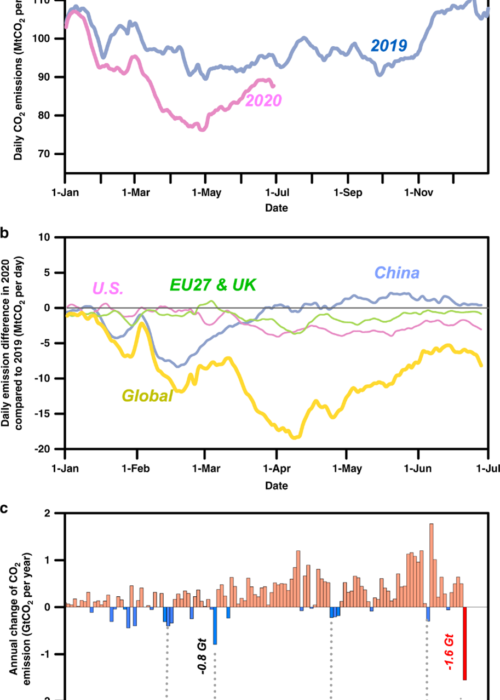Early in 2020, we witnessed an unprecedented reduction in global greenhouse gas emissions (GHG), as countries restricted travel and grappled with the COVID -19 crisis. An international team of researchers has found that in the first six months of 2020, 8.8 percent less carbon dioxide was emitted than in the same period in 2019, a total decrease of 1551 million tonnes. (Source: Liu, 2020)
Figure 1 Graph Effects of COVID-19 on global CO2 emissions.

a Daily CO2 emissions in 2019 and 2020 (7-day running mean)
b Global emissions aggregate different timing of effects in different regions (7-day running mean)
c COVID-19 causes the largest annual decrease of CO2 emission since 1900
(Source: Liu, 2020)
The decrease was larger than during previous economic downturns or World War Two. It offered a glimpse into what could be achieved, if we collectively took dramatic actions to reduce GHG emissions.
However, according to a new modelling study published in the Nature Journal, even if we made drastic reductions permanent, it would still not be enough. The researchers suggest the earth’s temperatures would continue to rise because of self-sustaining melting ice and permafrost. They suggest that we are past the point of no return when it comes to the melting of permafrost, using emissions reductions as the only tool. They modelled how much CO2 must be removed from the atmosphere every year from 2020 in order to avoid self-sustained temperature rise in the centuries ahead. The answer is 33 GtCO2e per year. (Randers, 2020)
Researchers suggest that even if we dramatically reduce GHG emissions now, it may not be enough due to climate feedback loops and now is the time to invest in large scale carbon capture.
The UK government has the ambition of having the option to deploy Carbon Capture Usage and Storage (CCUS) at scale during the 2030s. The Department for Business, Energy & Industrial Strategy published a report in August 2020 which identifies and assesses a range of high-level deployment options for industrial carbon capture, usage and storage (CCUS) technology in the UK. The report can be accessed here.
As environmental professionals are we ready to tackle this challenge and support the opportunity for mass deployment of CCUS or yet to be tested Negative Emission Technologies?
References:
Liu, Z., Ciais, P., Deng, Z. et al. Near-real-time monitoring of global CO2 emissions reveals the effects of the COVID-19 pandemic. Nat Commun 11, 5172 (2020). https://doi.org/10.1038/s41467...
Randers, J., Goluke, U. An earth system model shows self-sustained melting of permafrost even if all man-made GHG emissions stop in 2020. Sci Rep 10, 18456 (2020). https://doi.org/10.1038/s41598...
Please note: the views expressed in this blog are those of the individual contributing member, and are not necessarily representative of the views of IEMA or any professional institutions with which IEMA is associated.
Subscribe
Subscribe to IEMA's newsletters to receive timely articles, expert opinions, event announcements, and much more, directly in your inbox.
Posted on 2nd December 2020
Written by Clare Day
Latest Posts
-
IA Outlook Journal Volume 21: Impact Assessment Frontiers Part 2: People, Health and Equality
- 22nd July 2024 -
IEMA responds to Carbon Border Adjustment Mechanism (CBAM) consultation - July 2024
- 19th July 2024 -
The detail and policy action required beyond the King’s Speech
- 19th July 2024 -
Energy and Housing Bills included in the King’s Speech
- 17th July 2024 -
Launch of new resource for conservation technology tools
- 11th July 2024 -
Natural Capital 101: Guide for Sustainability Professionals
- 9th July 2024